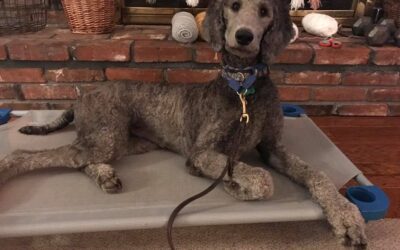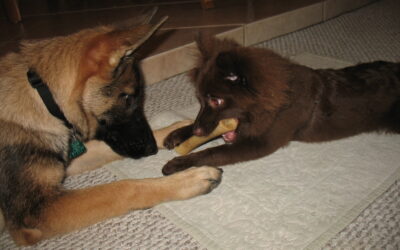 Remember when you just got your dog or puppy? You kind of had them on “double secret probation”at first, they were crated more, watched closer, maybe kept on leash in the house, and not allowed to stray out of sight too much. As you grew to trust them more they got more freedom, when they showed you they had earned it. 🙂
Remember when you just got your dog or puppy? You kind of had them on “double secret probation”at first, they were crated more, watched closer, maybe kept on leash in the house, and not allowed to stray out of sight too much. As you grew to trust them more they got more freedom, when they showed you they had earned it. 🙂
Well, there’s a time to go back to tighter rules even if life has been smooth sailing and relatively problem free. I very frequently hear of a dog getting into trouble seemingly “out of the blue”, and once I interview the owner the reason is typically there was a household change that threw the dog for a loop – the dog feels it needs to test the ropes again and see what exactly it can and cannot do.
Here’s a list of the main things that will throw a dog into trying new behaviors (or old behaviors we thought we had trained out):
1. Household member added or leaves – This could be a person moving out, a new baby arrives, a senior dog dies, a new puppy is added. Uncle Fred comes to visit and never leaves. Some dogs are immune to this, especially if you live in a house where dogs are constantly coming and going like a trainer or a fosters house, but many dogs are deeply affected and have to test to see where they fit in with the new scenario. The less change that happens there typically the more dogs will be affected when there is change.
2. Illness in family – Someone in the family being very ill can produce behavior problems too. I’ve seen owners with cancer, or diseases that affect stability, dogs that are elderly and can’t move well, all of these can be a monkey wrench in a dogs regular life. Some dogs become more solicitous, many will pick on the ill member of the group or simply disregard them. If the dog itself is ill or injured that can change behavior profoundly too. Many dogs go to great lengths to appear uninjured so they do not draw attacks from the group, and a dog that feels poorly is far more likely to be snappish and aggressive.
3. Location change – Moving to a new house really shakes things up for a dog. Especially if the location change is accompanied by a household group member change. These changes can be especially tough on a dog that goes from access to larger open areas to smaller open areas, or into an apartment with no outside running area at all. Again if location changes aren’t frequent this will impact a dog more.
4. Reproductive status changes – a female dog in heat, a male that has grown into sexual maturity, a pregnant dog or a pregnant owner. Even dogs that are altered can be affected by these changes around them.
5. Activity level change – A dog that got walked a lot that isn’t walked any more, a dog that has frequent activities removed, these can trigger behavioral changes. Combined with another area (say for example owner has cancer and can’t walk dog) it greatly increases the chance of behavioral swings.
I’m probably missing a few but these are the main ones I see that trigger major behavioral changes.
I highly recommend that if you have a dog that will be going through the above (or you are seeing behavioral changes right now based on the above) go ahead and tighten up the rules again for a while. More crate time when unsupervised, make sure to do obedience work, just put more structure in general back into dog’s life until the new normal settles in – maybe a few weeks to a month. I tell my board and train clients to go back to the routine I sent the dog home with for a bit.
Maybe a light bulb just went on over your head and something your dog is doing now makes sense. If you need help in a situation like that feel free to reach out to me through my website, http://redeemingdogs.com. I’ll either help you or find you someone in your area that can.





